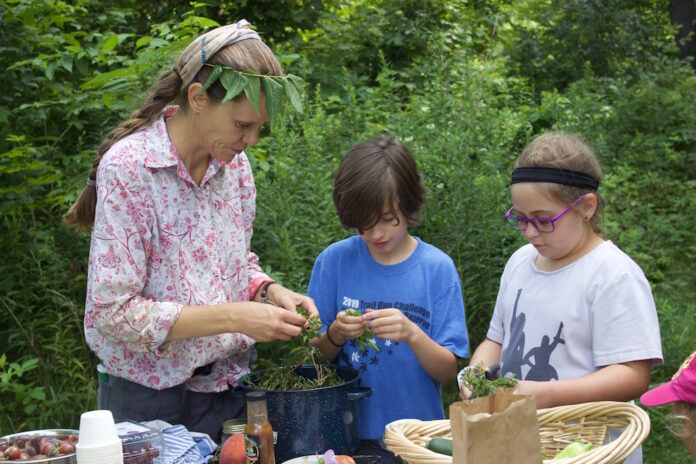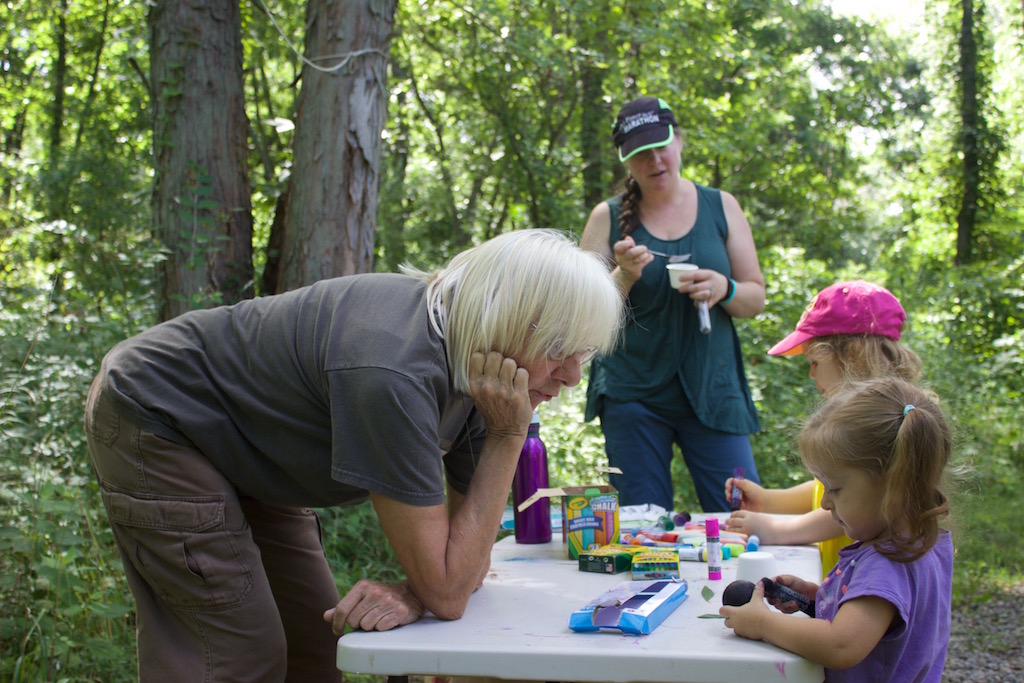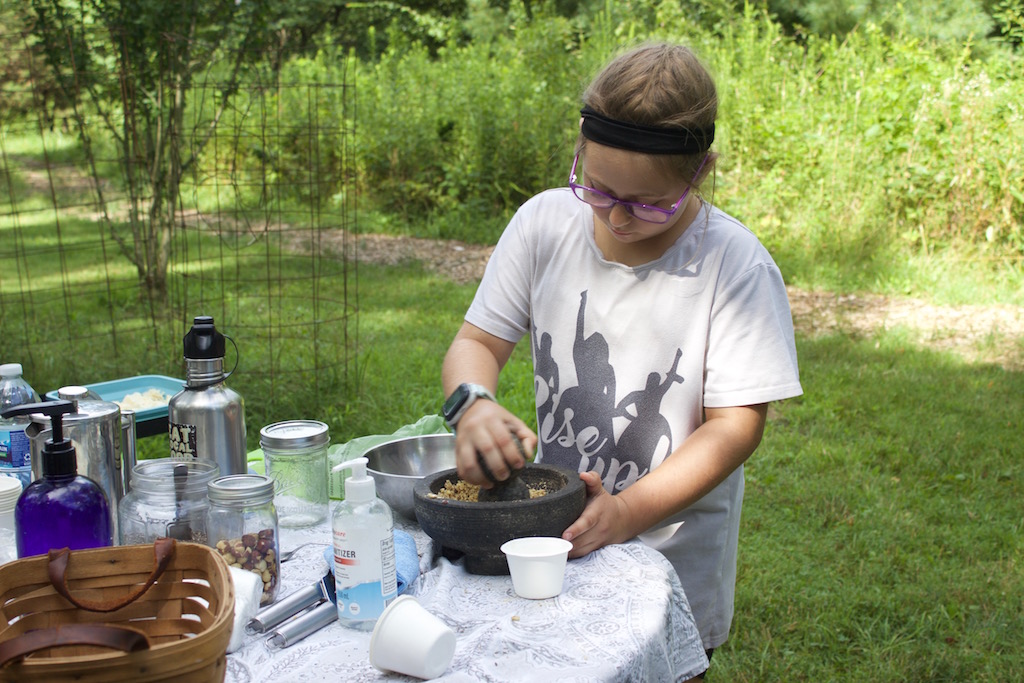
DAYTON, Ohio — In a clearing in a forest on a recent Saturday, Suzanne Slavens pointed out nuts, plants and other foods laid out on a table while children gathered around. They could make hazelnut or walnut butter with some of them, she suggested. The children settled on hazelnut butter and got to work mixing ingredients in a bowl.
“We could grow some hazelnuts in our forest,” Slavens, one of the founders of Elder Tree Forest School, told them. “These both, we can grow in our forests.
At a July 30 “forest fiesta” at the school, the children made the hazelnut butter. Volunteers also helped them prepare salads and other food with ingredients that can be found in Ohio forests.
The hazelnuts and walnuts, along with most of the other ingredients on the table, are native to Ohio. At discovery days in July, Slavens and other volunteers explored forest farming with children and families from the area. It’s all part of Elder Tree’s vision: to help children connect with nature, and to encourage interest in agroforestry in Ohio.
“Nature has been a central part of my well-being, and I believe that nature is incredibly important for human health, specifically mental health,” Slavens said. “I feel like we’re setting kids up for success later on in life … if they’re able to feel connected to nature.”
Elder tree
The earliest form of Elder Tree began in California, where Slavens worked on ecology programs for children with high school and college volunteers for the Irvine Ranch Outdoor Education Center, in Orange County.
When the pandemic hit in 2020, they continued to offer programs virtually. But a little later that year, Slavens relocated to Ohio when her husband got a job there, and the program began to evolve.
“We discovered how much support there is in Ohio for nonprofits doing this kind of work,” said Maya Chen, who started volunteering on nature education programs with Slavens in California as a high school student, in 2017. Chen is now one of the founding members of Elder Tree’s board.
When Slavens moved to Ohio, she started attending St. Paul the Apostle Orthodox Church, in Dayton. The church has about 10 acres of forest on its property, and wasn’t using it. So, she approached the church about holding outdoor education programs there, and the church agreed to let her use the space.
Ohio is different from California in a multitude of ways. It has a wider range of forest crops, from fungi to hazelnuts, Slavens said, and an abundance of freshwater compared to California.
“It’s just richer with forest food,” Slavens said. “It’s like a garden of Eden.”
But one similarity between the states is the support the program has received from communities and from parents who want their children to be able to connect with nature.
“I think we did have a really strong community back in California that we built up over time, and we’ve been able to transplant here and find another home,” Chen said.

Discovery days
Elder Tree’s most recent program was a series of discovery days for children that ran through July on Saturdays. Students in the program learned about food that grows in the forest, including persimmons, blackberries, pawpaws and more.
On each of the five Saturdays, the program hosted anywhere from a dozen to 30 children, 10 years old and younger.
At the July 30 forest fiesta, they also looked for walnut trees in the forest, and made black walnuts out of craft supplies at another station.
“I really want her to value being outside, and there’s only so much I can teach her,” said Jen Buckner, of Springboro, who brought her daughter, Laurel Edmonds, 3, to the discovery days. “I’ve been trying to find educational opportunities that aren’t indoors and that don’t incorporate worksheets.”
For each lesson, Chen and Slavens come up with a flexible plan that involves starting with a song, and offering different stations with crafts and games for the students.
“I think there’s a lot of power in being in natural settings and reconnecting with the earth. And a lot of students don’t always get that experience nowadays,” Chen said.

Passion project
For now, the work Slavens and Chen are doing with Elder Tree is all volunteer work. Chen, who just graduated from college, was able to spend the summer in Ohio to focus on Elder Tree before going back to a full-time job in California.
A Sustainable Agriculture Research and Education grant has helped them spend more time on the project and supported them adding more programs for the fall.
Slavens and volunteers from the church have also been working on managing the forest on the church’s property. That involves getting rid of invasive species, like honeysuckle, and planting more trees.
In the fall, Elder Tree volunteers and the children in their programs will plant more trees and other native species in the forest. Slavens encouraged children and parents at the last discovery day to think about what they might be interested in helping to plant in the fall and to let her know what they’re excited about growing.

Vision
This fall, Elder Tree is planning to work more on outreach to high schoolers. They had a few high school volunteers at some of the discovery days. Slavens is hoping by getting more teenagers involved in volunteering and teaching younger children, they can also help older students learn about forest farming.
“The best way to learn something is to teach it,” she said.
Her long-term vision for Elder Tree is to offer forest school programs after school on weekdays, focused on a wide range of environmental topics.
“Our main mission is to connect to the world to promote wellness,” Slavens said.
She also wants to encourage interest in forest farming, or agroforestry, for young people. Some of the high school and college students she’s talked to about volunteering have never heard of “farming in the shade.” She sees agroforestry as a way to farm while also keeping trees on the land, for the benefit of the climate.
“If we can feed humans while keeping trees, we’re going to make something good happen as far as sustainability goes,” Slavens said.











